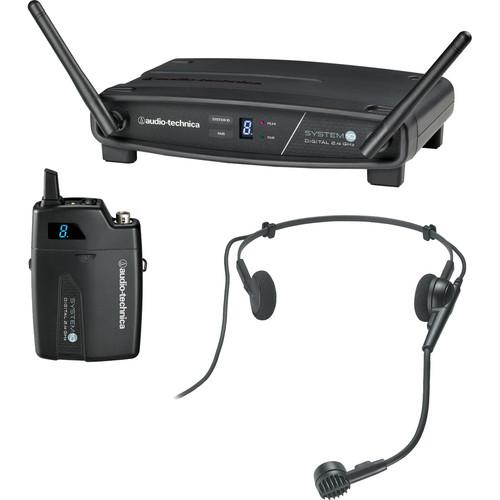
Audio-Technica ATW-1101/H System 10 Digital Wireless Headworn Dynamic Microphone Set
Audio-Technica ATW-1101/H Overview
The ATW-1101/H System 10 from Audio-Technica is a digital wireless headworn microphone solution for drummers, keyboardists, dancers, instructors and others that require the use of their hands during performance. The set includes the ATW-R1100 digital receiver, the ATW-T1001 UniPak pocket transmitter and the PRO 8HEcW headworn microphone. It uses 24-bit, 48 kHz digital audio and operates free from TV interference in the 2.4 GHz frequency range. Built for expandability, you can use up to eight systems simultaneously.
The PRO 8HEcW dynamic headworn microphone is designed to offer accurate, close range capture of an individual voice. The cushioned headband is designed to fit comfortably on your head and it can be worn on either the left or right side. The capsule features a hypercardioid polar pattern that promotes isolation of the vocal source by rejecting outside sound from floor monitors, drum sets, crowd noise, etc. This lends to consistent sound quality and high gain before feedback. The mic is fitted with a windscreen to filter out pops from breath and wind noise, and it has a dynamic Hi-ENERGY neodymium element that does not require phantom power. It has a 55" cable that terminates with a locking 4-pin connector which plugs into the ATW-T1001 UniPak pocket transmitter.
The ATW-1101/H wireless system is engineered to quickly find the best signal possible, utilizing an automatic frequency selection function that chooses open bands for you when you "pair" your transmitter with the receiver. Also designed to combat interference, the ATW-1101/H uses three different diversity techniques. Using frequency diversity, the system sends the wireless signal on two separate channels simultaneously and chooses the one with the clearest signal. It also transmits the signal across multiple intervals in time in order to fight multipath interference. This is known as time diversity. Furthermore, the system also makes use of space diversity, choosing between the receiver's dual antennas depending on which is picking up the best signal integrity.
